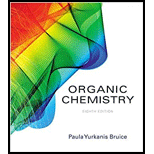
Concept explainers
Draw short segments of the

(a)
Interpretation:
The short segment of polymer obtained from the given monomer has to be drawn and also have to indicate whether it is a chain growth or step growth polymer.
Answer to Problem 24P
The short segment of given monomer is shown below and the monomer undergoes chain growth polymerization.

Explanation of Solution
Given the monomer is
The short segment of polymer obtained from this monomer is given below.

The polymer formed is a Chain growth polymer because monomer addition occurs at the end of the chain.
(b)
Interpretation:
The short segment of polymer obtained from the given monomer has to be drawn and also have to indicate whether it is a chain growth or step growth polymer.
Answer to Problem 24P
The short segment of given monomer is shown below and the monomer undergoes chain growth polymerization.

Explanation of Solution
Given the monomer is
The short segment of polymer obtained from this monomer is given below.

The polymer formed is a Chain growth polymer because monomer addition occurs at the end of the chain.
(c)
Interpretation:
The short segment of polymer obtained from the given monomer has to be drawn and also have to indicate whether it is a chain growth or step growth polymer.
Answer to Problem 24P
The short segment of given monomer is shown below and the monomer undergoes step growth polymerization.

Explanation of Solution
Given the monomer is

The short segment of polymer obtained from this monomer is given below.

The polymer formed is a Step growth polymer because monomer addition occurs not at the end of the chain and these polymers are formed by combining monomers by removing small molecules of water or alcohol.
(d)
Interpretation:
The short segment of polymer obtained from the given monomer has to be drawn and also have to indicate whether it is a chain growth or step growth polymer.
Answer to Problem 24P
The short segment of given monomer is shown below and the monomer undergoes step growth polymerization.

Explanation of Solution
Given the monomer is

The short segment of polymer obtained from this monomer is given below.

The polymer formed is a step growth polymer because monomer addition occurs not at the end of the chain and these polymers are formed by combining monomers by removing small molecules of water or alcohol.
(e)
Interpretation:
The short segment of polymer obtained from the given monomer has to be drawn and also have to indicate whether it is a chain growth or step growth polymer.
Answer to Problem 24P
The short segment of given monomer is shown below and the monomer undergoes step growth polymerization.

Explanation of Solution
Polymers are formed from linking small units called monomers and they are classified into Chain growth polymers and Step growth polymers.
Given the monomer is

The short segment of polymer obtained from this monomer is given below.

The polymer formed is a Step growth polymer because monomer addition occurs not at the end of the chain and these polymers are formed by combining monomers by removing small molecules of water or alcohol.
Want to see more full solutions like this?
Chapter 27 Solutions
ORGANIC CHEMISTRY-W/S.G+SOLN.MANUAL
- What is the final product when D-galactose reacts with hydroxylamine?arrow_forwardIndicate the formula of the product obtained by reacting methyl 5-chloro-5-oxopentanoate with 1 mole of 4-penten-1-ylmagnesium bromide.arrow_forwardIn the two chair conformations of glucose, the most stable is the one with all the OH groups in the equatorial position. Is this correct?arrow_forward
- please help me with my homeworkarrow_forwardhelparrow_forwardThe temperature on a sample of pure X held at 1.25 atm and -54. °C is increased until the sample boils. The temperature is then held constant and the pressure is decreased by 0.42 atm. On the phase diagram below draw a path that shows this set of changes. pressure (atm) 2 0 0 200 400 temperature (K) Xarrow_forward
- QUESTION: Answer Question 5: 'Calculating standard error of regression' STEP 1 by filling in all the empty green boxes *The values are all provided in the photo attached*arrow_forwardpressure (atm) 3 The pressure on a sample of pure X held at 47. °C and 0.88 atm is increased until the sample condenses. The pressure is then held constant and the temperature is decreased by 82. °C. On the phase diagram below draw a path that shows this set of changes. 0 0 200 temperature (K) 400 аarrow_forwarder your payment details | bar xb Home | bartleby x + aleksogi/x/isl.exe/1o u-lgNskr7j8P3jH-1Qs_pBanHhviTCeeBZbufuBYT0Hz7m7D3ZcW81NC1d8Kzb4srFik1OUFhKMUXzhGpw7k1 O States of Matter Sketching a described thermodynamic change on a phase diagram 0/5 The pressure on a sample of pure X held at 47. °C and 0.88 atm is increased until the sample condenses. The pressure is then held constant and the temperature is decreased by 82. °C. On the phase diagram below draw a path that shows this set of changes. pressure (atm) 1 3- 0- 0 200 Explanation Check temperature (K) 400 X Q Search L G 2025 McGraw Hill LLC. All Rights Reserved Terms of Use Privacy Cearrow_forward
 Introductory Chemistry: An Active Learning Approa...ChemistryISBN:9781305079250Author:Mark S. Cracolice, Ed PetersPublisher:Cengage Learning
Introductory Chemistry: An Active Learning Approa...ChemistryISBN:9781305079250Author:Mark S. Cracolice, Ed PetersPublisher:Cengage Learning Chemistry: Principles and PracticeChemistryISBN:9780534420123Author:Daniel L. Reger, Scott R. Goode, David W. Ball, Edward MercerPublisher:Cengage Learning
Chemistry: Principles and PracticeChemistryISBN:9780534420123Author:Daniel L. Reger, Scott R. Goode, David W. Ball, Edward MercerPublisher:Cengage Learning
 Organic ChemistryChemistryISBN:9781305580350Author:William H. Brown, Brent L. Iverson, Eric Anslyn, Christopher S. FootePublisher:Cengage Learning
Organic ChemistryChemistryISBN:9781305580350Author:William H. Brown, Brent L. Iverson, Eric Anslyn, Christopher S. FootePublisher:Cengage Learning Chemistry: The Molecular ScienceChemistryISBN:9781285199047Author:John W. Moore, Conrad L. StanitskiPublisher:Cengage Learning
Chemistry: The Molecular ScienceChemistryISBN:9781285199047Author:John W. Moore, Conrad L. StanitskiPublisher:Cengage Learning





